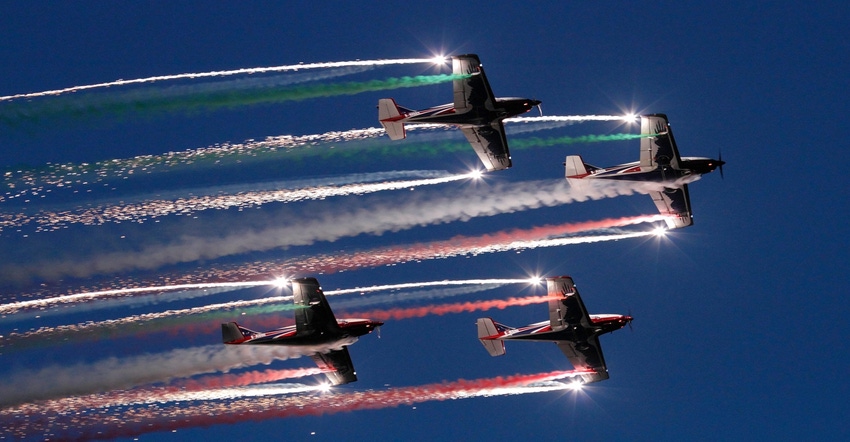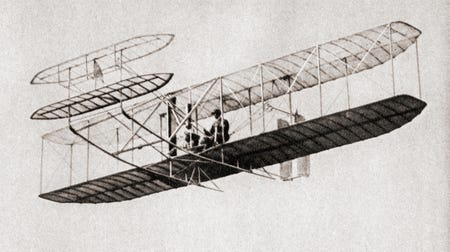Take time to soar on National Aviation Day. It’s on August 19, Orville Wright’s birthday.
August 17, 2022

In 1939, Franklin D. Roosevelt issued a presidential proclamation designating August 19 as National Aviation Day. He chose that day because it was Orville Wright’s birthday. This was 36 years after the Wright Brothers flew the first heavier-than-air flying machine in 1903. By 1939, aviation was a thriving industry in the US and around the world.

New world speed and distance records were being set, airlines that still exist today were being formed, and, when World War II began, both Allied and Axis Powers sought new ways to beef up aviation’s role in warfare.
FDR Offers a Free Drink of Aviation Gin
In 1939, the National Advisory Committee for Aeronautics (NACA) – NASA’s organizational predecessor – was 24 years old and was already well established as the nation’s premier aviation research laboratory in Virginia. That year, a brand new center was approved for construction in California.
The fundamental problems with flight were being solved by engineers on drawing boards and in the wind tunnels of NACA, enabling aircraft to fly faster, higher, farther, and with more and more cargo and passengers.
NASA Offers Ideas for Celebrating National Aviation Day
In celebrating National Aviation Day, Jim Banke, a communications specialist at the Aeronautics Research Mission Directorate, offers a list of possible activities to send the holiday into the skies.
1. Spread your wings
Have someone take a picture of you and your friends or loved ones stretching out your arms like the wings of an airplane. Tell us how you're celebrating flight on Thursday, August 19. Post your photo to Twitter, Facebook, Instagram, or any other social media. Be sure and tag it with #NationalAviationDay so NASA can see it!
2. Remember that NASA is with you when you fly
Are you traveling by air today or anytime soon? After you settle into your assigned seat, buckle up, make sure your seatback and folding tray are in their full upright positions, and then take a moment and think about NASA. Why? Well, it might not be immediately visible to you, but every U.S. aircraft and air traffic control tower in operation today uses some kind of NASA-developed technology.
Before you take off, glance into the cockpit. See all the electronic displays? They make up what's called the glass cockpit. NASA did early testing on using the displays to replace heavier and outdated dials and gauges.
Now, look out your window. See the vertical extension on the tip of your airplane's wing? That's a winglet. It was developed by NASA as a way to reduce drag. In use now for nearly 20 years, winglets have saved billions of gallons of fuel, according to industry. And they even reduce aircraft noise a bit.
Then there are the things you won't see. It may be a piece of technology buried deep within your jet engine to help it run more efficiently, or it could be computer software installed in air traffic control centers to help controllers manage your flight, gate-to-gate, more efficiently with reduced delays, all in a way that's more Earth-friendly.
3. Visit your local science museum or NASA visitor center
Exhibits about aviation and how an airplane flies are popular staples of local science museums. Check out your local science center to see if they’re open and how they handle aviation, and even if they don't, it never hurts to spend some time learning about science.
Visitor centers for NASA’s Langley Research Center near Norfolk, Virginia, and Glenn Research Center in Cleveland – two of the four NASA field centers that conduct aeronautics research – are open. For information about these facilities, and others associated with NASA, visit this resource page.
4. Watch an aviation-themed movie
There's no shortage of classic aviation-themed movies available to watch. A few NASA aeronautics staff favorites include Jimmy Stewart's "The Spirit of St. Louis" or “Strategic Air Command” – or, more recently, Amazon Prime’s “The Aeronauts,” National Geographic’s “Living in the Age of Airplanes,” or Disney's animated "Planes." Movies that combine aviation and space can be fun, such as “The Right Stuff” or the documentary “One More Orbit,” which tells how former NASA astronaut Terry Virts attempts to break the speed record for circling Earth over the poles in a business jet.
5. Take an introductory flight lesson
Pilots will tell you there is a wonderful sense of freedom in flying, not to mention the incredible views and the personal sense of accomplishment that comes from mastering the skills required to fly. At the same time being a pilot is not for everyone – but you won't know unless you try!
Most general aviation airports in the nation have a flight school that offers an introductory flight lesson at a discounted price. Many airports have flying clubs that will introduce you to flight. You also might check to see if there is a Civil Air Patrol in your area.
And if you want a taste of flight from the cockpit without leaving the ground, commercial computer desktop flight simulators such as X-Plane 11 or Microsoft’s new Flight Simulator are popular choices and can get you into the virtual sky in short order.
6. Build an airplane
Why not? It doesn't have to be big enough to fly in – although homebuilt airplane kits are available if you have the money, time, and perseverance to complete the job.
Putting together a smaller plastic model kit of one of the world's most historic aircraft can be just as rewarding and just as educational, especially for younger kids who might be thinking about a career as an engineer or aerospace technician.
Many astronauts will tell you their love of aviation and space began with putting models together as a child. Another idea: Grab some LEGO bricks and build the airplane of your dreams, or perhaps one based on real NASA work like these folks did.
Or make it easy on yourself: fold a paper airplane like this one of NASA’s X-59 Quiet SuperSonic Technology aircraft and shoot it across the room. Sometimes simple works best.
7. Tell us about your first flight
For National Aviation Day in 2014, NASA asked for people's stories about their first flights. NASA received some great ones, and they’d love to hear from you about the first time you ever flew in a plane. Post your story online and be sure to use #NationalAviationDay so they can find you. Tell them about the first time you took to the air. Where were you traveling? Why? Do you remember what kind of airplane it was? Were you thrilled, or a little scared?
8. Follow what we're doing to transform aviation
NASA's aeronautical innovators are working to transform air transportation to meet the future needs of the global aviation community. There are many ways in which NASA is doing this. Improving an airplane's aerodynamics, reducing the amount of fuel used by airplanes, making airplanes of all sizes quieter, decreasing the amount of harmful emissions released into the atmosphere, working with the Federal Aviation Administration to improve the efficiency of air traffic control – the list could go on for many thousands of more words. Bookmark the NASA Aeronautics home page and follow NASA on Twitter @NASAaero.
There are also some great educational resources that not only help you learn about NASA’s aeronautics research but about aviation in general. Visit our Cool Aero Stuff page to download fact sheets, coloring pages for kids, mini posters, and much more. Even more fun things to do at home can be found here.
9. Visit your local library or download a NASA e-book
Aviation-themed books, whether fact or fiction, are all over the shelves of your local library – literally. That's because there's no single Dewey Decimal number for aviation. A book about aviation history will be in a different section of the library than a book about how to design an airplane. And fictional books such as the Arthur Hailey classic "Airport," or autobiographies such as Chuck Yeager's "Yeager," are off on yet another shelf somewhere else. Don't hesitate to ask your reference librarian for help. And when you get back from the library, or while still there, jump online and check out the NASA e-books you can download for free.
10. Have a plane spotting picnic near an airport
At Washington DC’s Ronald Reagan airport it's Gravelly Point. In Minneapolis, it's Post Road. If you live near a major international airport, chances are you know the best place where the locals can go to watch aircraft take off and land. Be sure to take heed of any security restrictions about where you can and can't go.
But once you have your spot picked out then load up your picnic basket with lots of good stuff and camp out next to the airport for an afternoon of plane spotting. See how many different types of airplanes you can count or identify. For a truly up-close and personal experience, bring a scanner radio and listen in on air traffic control. This wikiHow page offers some helpful plane spotting tips.
About the Author(s)
You May Also Like





